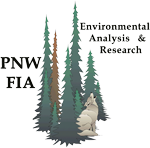Fuel Treatment Cost Effectiveness (FTCE)
Evaluating cost-effectiveness of multi-purpose fuel treatments in western mixed-conifer forests considering hazard, risk, longevity and co-benefits

In this project, the effectiveness and costs of mechanical fuel treatments designed to reduce fire hazard and enhance fire resistance were explored, focusing on dry mixed-conifer forests across 13 FVS variant regions in CA, OR, WA, ID, and MT. By applying the BioSum analysis framework, the FIA sample, representing 29 million acres, and consisting of over 7000 conditions, become stands that get modeled in FVS. These stands cover almost every gradient imaginable, across density, volume site quality, age, structure complexity, species fire tolerance, terrain, road access and proximity to wood processing sites. Where a stand sits in this hyperspace determines its inherent resistance, amenability to restoration treatment, longevity of treatment benefits, and net treatment costs or revenues. Map shows the FIA plot locations and FVS variant boundaries that were used in this study.
Relying on the FVS Stratum table output as a basis for characterizing forest structure and drawing on prescription examples shared during interview with silviculturists across the region, three stand types were recognized:
1) multi-storied stands - for which we devised six versions of an "improvement cut" prescription designed to maintain multi-storied stand structure while reducing overstory canopy density and tree count,
2) single story stands - which we addressed with three versions of a "commercial thin" prescription,
3) young stands containing trees too small to be suitable for either of these kinds of prescriptions - which we did not model for this study.
Because every stand in a BioSum analysis is tied to a representative location on the ground, and the forest type owner, and myriad site factors associated with that location, it's easy to use these factors as a basis for summarizing any stand level metric collected by FIA or computed in FVS. Or, such as in this case, a fire vulnerability class assignment derived from a complex resistance rating process that builds on attributes from those models as well as exogenously calculated information.
FTCE Products
Publications
Bell, C.K., R.F. Keefe, and J.S. Fried. 2017. OpCost: an open-source system for estimating costs of stand-level forest operations. Gen. Tech. Rep. PNW-GTR-960. Portland, OR: U.S. Department of Agriculture, Forest Service, Pacific Northwest Research Station 23 p.
Bell, C.K., R.F. Keefe, and J.S. Fried. 2017. Validation of the OpCost logging cost model using contractor surveys. International Journal of Forest Engineering 28(2) 73-84.
Fried, J.S., T.B. Jain, S. Loreno, R.F. Keefe, and C.K. Bell. 2017. A framework for evaluating forest restoration alternatives and their outcomes, over time, to inform monitoring: bioregional inventory originated simulation under management. In Keyser, C.E. and T.L. Keyser, eds. Proceedings of the 2017 Forest Vegetation Simulator (FVS) Virtual e-Conference. E-Gen. Tech. Rep. SRS-224. Asheville, NC: U.S. Department of Agriculture Forest Service, Southern Research Station. 200 p.
Bell, C.K. and R.F. Keefe. 2014. FVS-OpCost: A New Forest Operations Cost Simulator Linked with FVS. Proceedings of the 37th Council on Forest Engineering Annual Meeting. Moline, Illinois
Presentations
Fried, J.S., T.B.Jain, S. Loreno, R. Keefe and C. Bell. 2017. Bioregional Inventory Originated Simulation Under Management: a framework for evaluating forest restoration alternatives and their outcomes, over time, to inform monitoring at the assessment phase, and beyond. Presented by Fried to the 2017 FVS e-Conference, February 28, 2017.
Fried, J.S., T.B.Jain, S. Loreno, R. Keefe and C. Bell. 2017. Scoping cost-effective, multi-metric hazard reduction opportunities over a forested landscape: trade-offs among opportunity costs, treatment intensity, effectiveness and longevity. Presented by Fried to the 17th Symposium on Systems Analysis in Forest Resources, Suquamish, WA. August 29, 2017.
Fried, J.S., T.B. Jain, S. Loreno, C. Bell, R. Keefe. 2016. Multi-dimensional cost-effectiveness of fuel treatments in dry mixed conifer forests: an inventory originated analysis. Presented by Fried at the 5th International Fire Behavior and Fuels Conference, Portland, OR, April 14, 2016.
Fried, J.S., T.B. Jain, S. Loreno, C. Bell, R. Keefe. 2016. Evaluating cost-effectiveness of multi-purpose fuel treatments in western mixed-conifer forests: Effectiveness Metrics. JFSP Workshop on Fuels Treatment Effectiveness, at the invitation of workshop leader JFSP Dep. PM Ed Brunson, Portland, OR April 11, 2016.
Fried, J.S. Modeling forest management and restoration opportunities with BioSum. 2016. Presented to the PNW-RMA Program Review, at the invitation of Andrew Gray, Portland, OR. February 9, 2016.
Jain, T.J., J.S. Fried and S.M. Loreno. 2015. Evaluating Fuel Hazard of Multipurpose Fuel Treatments in Dry Mixed-Conifer Forests. Presented by Jain at the Society of American Foresters National Convention, Baton Rouge, LA, November 6, 2015.
Fried, J.S., S. Loreno and L. Potts. 2014. FIA Biosum Analysis Tool: Whole Landscape-Scale Simulation of Management Effectiveness and Economics. Society of American Foresters National Convention, Salt Lake City, UT, October 10th, 2014.
BioSum Project Data
FTCE Mid (Central Region: BM, EC, SO and WS FVS variant regions). 19 June 2019 version. Zipped Project

